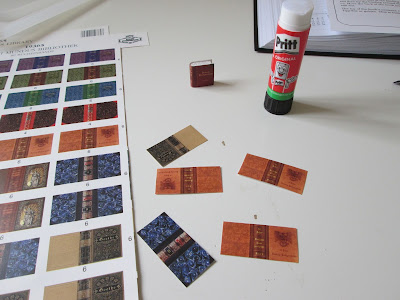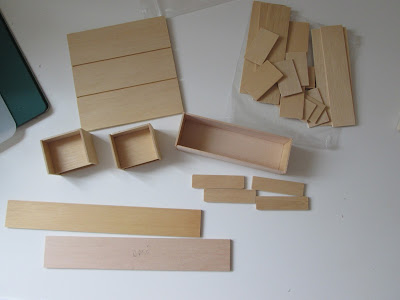My final decision on what finish to use on the ELF furniture was to use one coat of Danish Oil. My thinking being: if one liberal coat didn't look enough then, fine, I could always add another...
I loved the way it looked after it was buffed up. I actually used my not-Dremel rotary tool for the polishing and think it made a real difference - it is much beefier than doing it by hand.
When I came to make the things for my work room I wanted them to look like the bog-standard 'contiplas' sort of thing that you get in cheap Ikea flat pack stuff. (this is what my real ones are)
I thought if I constructed them and then tried to apply several coats of paint and rub down in between I was going to struggle with the 'joins'.
I did pre-assemble the Expedit (bookcase type thing) piece because that was so dependent on getting things in grooves and I didn't want those impeded in any way by paint. However, I was right in that it made the painting/sanding process more of a challenge.
The desk and table pieces were all painted first:
 |
| starting to assemble them |
They were assembled using my favourite DeLuxe glue which really does glue painted surfaces together. I add a couple of blobs of Super-Glue gel on every join, just to lock the pieces in place while the other glue dried. This also helps to keep everything squared up properly.
I did four coats of paint, followed by buffing and they look the part. this time I did the buffing by hand - the rotary tool was too hefty for the paintwork. To get a slight sheen on painted tings you just need the finest of fine abrasive as the last rubbing down process. A scrumpled brown paper bag, or scrumpled computer paper, a piece of kitchen roll, a coarse piece of cotton fabric, whatever you can bring to it that has enough fibres in it to act like the finest of sanders.
 |
| Expedit - the castors work |
 |
| my work table - bit of a 'nip' on the side but it is now fixed |
 |
| computer trolley - keyboard tray slides in and out and the castors work |
I know all these were bespoke but they are incredibly inexpensive and I get just what I want. Bookmark ELF there will be a time you need her magic.



















































